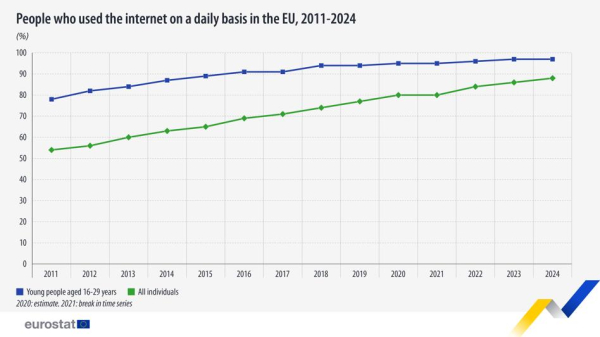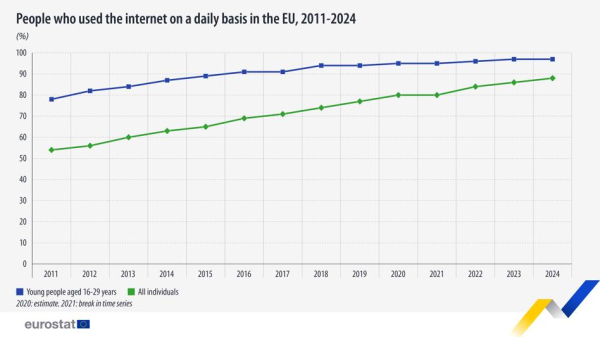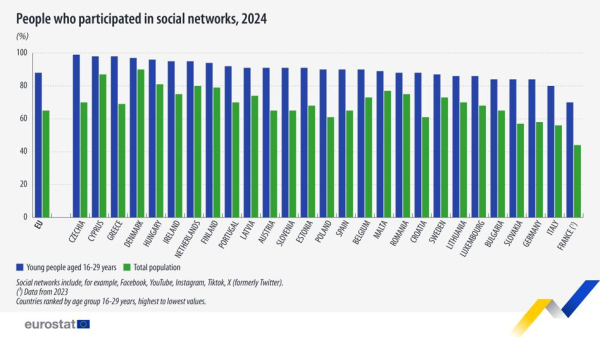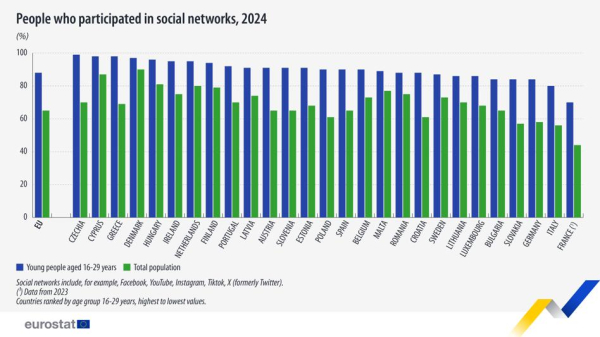The latest Eurostat data for 2024 shows that the internet has become an almost inseparable part of young people's daily lives. On average, 97% of young people across the EU use it daily.


In 2024, 97% of people aged 16–29 in the European Union reported using the internet daily, compared to 88% for the general population. By comparison, in 2015, the figures were 89% for young people and 65% for the general population. During the period under review, there was a steady increase in daily internet use across all age groups.
As the European Statistical Office notes, the pace of growth has been uneven – the difference between age groups, the so-called digital age gap, has been gradually narrowing. In 2015, the difference between the percentage of young people and the overall population using the internet daily was as much as 24% (89% among young people and 65% of the general population). By 2024, this difference had narrowed to just 9%.


Eurostat
The generational digital gap was highest in Croatia (20%), Greece (16%), and Poland, Portugal, and Bulgaria (15% each). In contrast, in the Netherlands, Ireland (1% each), and Denmark (2%), the differences were minimal.
In 2024, among the forms of online activity analysed by Eurostat, social media and voice and video calls were the most popular among young people.
On average in the EU, 88% of 16-29 year olds created a profile on a social networking site or posted content there, compared to 65% of the general population.
July 15th is National Phone-Free Day. Magdalena Bigaj, a digital hygiene educator from the Institute of Digital Citizenship, told PAP that “the problem with social media is very complex, because it's not only a matter of the structure of the platforms themselves, but also the content we follow.” “Too many short, contextually unrelated video or graphic materials from various sources create an 'information cocktail' for our brain that is difficult to process. The brain feels a strong need to analyze this information, but on social media it is unable to do so,” the expert explained, adding that the result is a feeling of fatigue and overstimulation.
In almost all EU countries – with the exception of Ireland and Malta – young people were more likely than the rest of the population to engage online in civic or political matters. In 2024, across the European Union, the figures were 26.1% and 20.5%, respectively. The highest levels of such activity among young people were recorded in Slovenia (51%), followed by Greece (37%) and Italy (35%). The lowest rates were recorded in Sweden (14%), the Czech Republic (16%), and Belgium (19%). In Poland, the figure was 20.8% among young people, compared to 15.8% among the general population.


Eurostat
Data released by Eurostat indicates that online courses, which gained popularity as a result of the COVID-19 pandemic, have now lost some of their importance. While 35% of young EU residents participated in online courses in 2021, this figure dropped to only 24% in 2024. In Poland, this percentage among young people also decreased (to 14.1% in 2024 from 22.5% in 2021). (PAP)
adz/ bst/ ktl/






